Generating electricity for the nation
In this chapter, you will learn about the various ways in which electricity is generated in different types of power stations. You will also compare the advantages and disadvantages of different types of power stations.
You will learn how electricity is distributed from the power stations to different parts of the country, to reach the people who use it.
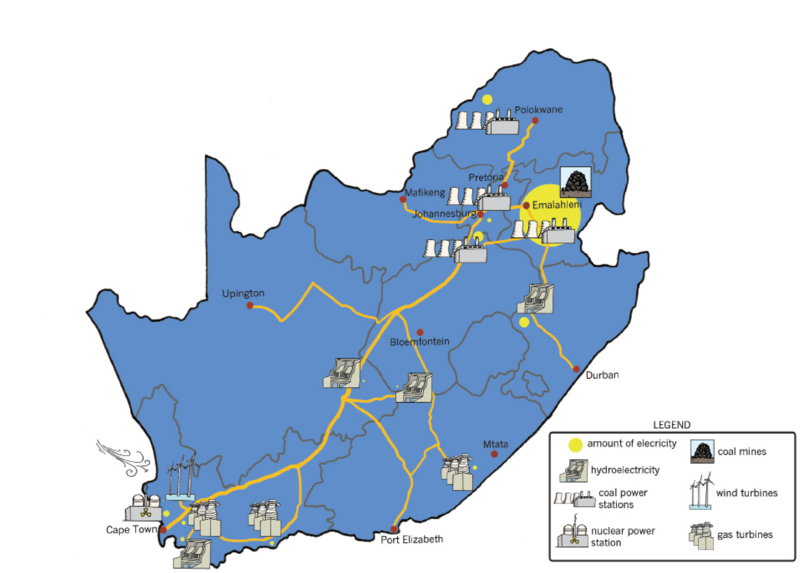
How electricity is generated in coal-power stations
When you switch a light on, where does the energy in the bulb come from? You can control the energy with a switch, but what is behind the switch?
In this chapter, you will find the answer to these questions, and find out where the power is generated. Before you investigate the country's electricity supply, you will look at the ways electricity can be generated, and how this affects your daily life.
South Africa uses many power stations for its electricity supply. There are different types of power stations: coal, nuclear, hydroelectric, gas, wind and solar. Figure 1 shows where in South Africa these different types of power stations are located.
There are no solar-power stations in South Africa yet, but plans are in progress to start building it.
You will start this week by learning about coal-power stations for two reasons:
- Most of the electricity in the country, about 85%, is generated by coal-power stations.
- Coal-power stations use the technologies of generators and turbines that are also used in most other types of power stations.
Generators
There are three main systems that give us energy for lights, computers, cell phones and all other electrical appliances. You can get energy from batteries, photo-voltaic panels and generators.
The main source of electricity in South Africa comes from large generators. These work exactly the same as any small generator you might come across. It is important to understand how a generator works as it is used in most types of power stations.
How a generator works
If you move a magnet near a coil of copper wire, you will create a voltage across the end of the copper wire. Look at Figure 2.
If you connect a bulb across the ends of the wire, a current will flow around the circuit. To make the current bigger, you can use more copper wire in the coils, use a stronger magnet, or move the magnet faster.
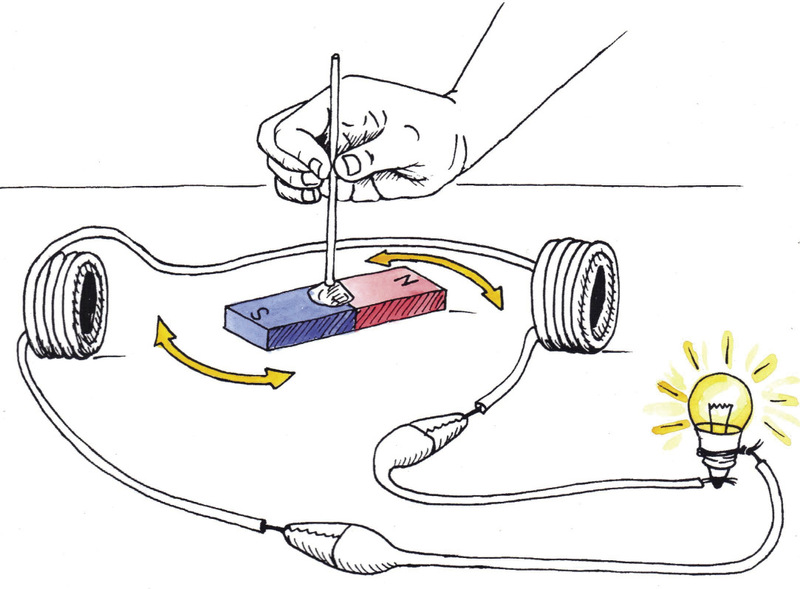
If the person in the picture leaves the magnet on the table, how much current will flow in the circuit? Your answer can be "a big current", "no current" or "a small current". Give a reason for your answer.
Now look at the girl on the bicycle. She is pedalling fast and has a generator connected to the back wheel of her bicycle. A bicycle generator is also called a "dynamo".
The dynamo gives energy to the lamp only when the roller is spinning. The girl on the bicycle has to pedal faster than usual since she is transferring some of her energy to the dynamo, which not only makes her wheels move, but also lights the lamp.
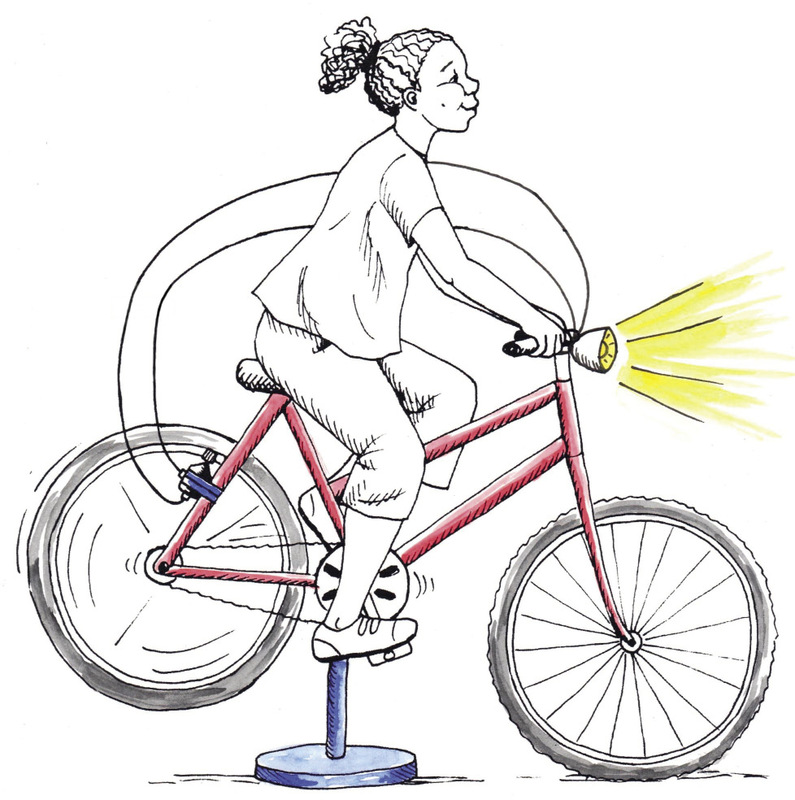
If you open a dynamo, you will see that it has copper coils similar to the drawing in Figure 2. As the girl pedals, the copper coils spin inside the magnets, and this movement generates electricity.
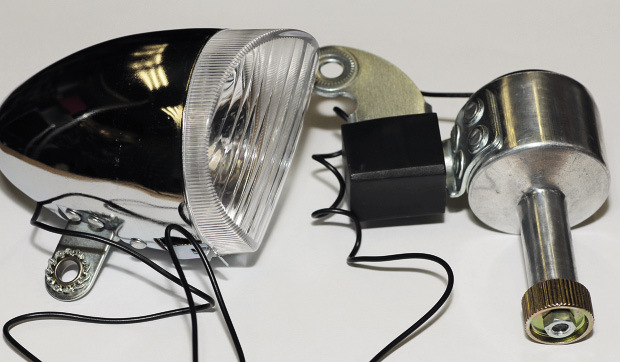
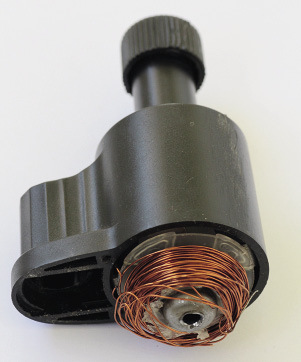
Power stations have big dynamos called generators. They work exactly the same way as the dynamo in the pictures above but are much, much bigger! They also require a lot more energy to turn than only one person pedalling. In the next section, you will learn the various ways energy is provided to these big dynamos.
Thermal power stations
Thermal means "caused by heat". In thermal power stations, turbines are driven by steam. The steam is formed by evaporating water through a source of heat. The water is heated to form high-pressure steam by using a heat source such as burning coal or gas, nuclear reactions, or light from the sun. The water is turned into steam that drives a turbine, which makes an electrical generator turn. An electrical generator can also be called an "alternator". After the steam has been used, it is cooled down so that the water can be used again.
Most of the world's energy comes from burning fossil fuels such as coal, oil or natural gas. This results in high levels of air pollution, particularly from greenhouse gases that contribute to climate change. Fossil fuels will run out in the future.
Fossil fuels are carbon-based fuels that are taken from the earth, and are made of the remains of living things that died millions of years ago.
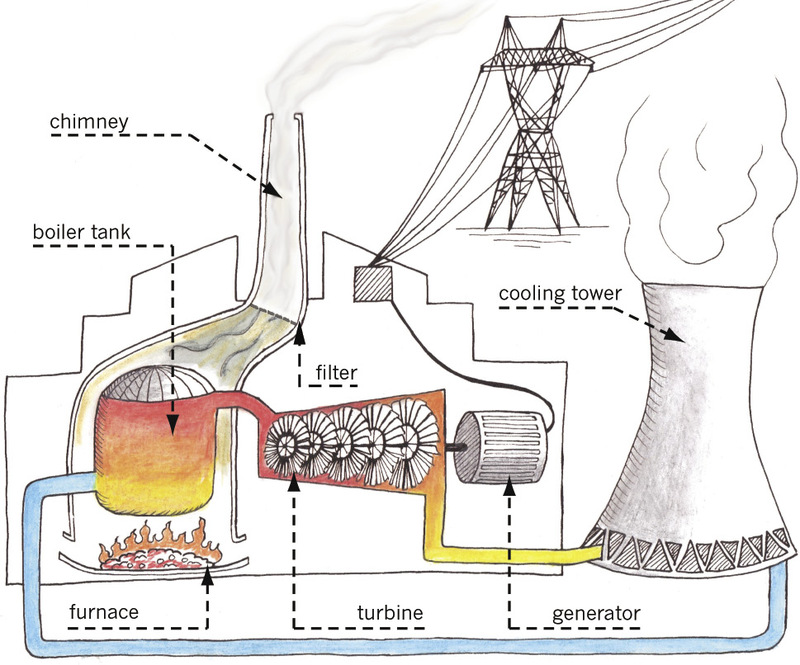
Coal-fired power stations
The energy conversion process starts with the burning of coal that generates heat to convert water into steam at a very high temperature and pressure. The heat and pressure energy contained in the steam is used to drive the turbines, converting it into a rotational movement, in other words kinetic energy. You saw an example of this with the bicycle dynamo − it is exactly the same process. There is a generator attached to the turbine shaft.
- Reasons for using coal as an energy source
For centuries, coal was the only fuel source available in large quantities. Power stations were built near coal mines so that coal did not have to be transported over long distances.
Most of the coal-fired power stations in South Africa are found in Mpumalanga where huge coal deposits were discovered. Coal-power stations are the cheapest way to generate electricity. It is even cheaper in South Africa since the coal here is close to the surface and therefore easy to mine.
- Impact on the environment
Burning fossil fuels creates air pollution due to the carbon dioxide that is emitted during the process. The fires needed to produce steam from water emit a lot of carbon dioxide into the air, a lot more than a wood or coal fire in your home does. Coal has been used for centuries to generate heat.
Sulphur dioxide and nitrogen oxide are two other gases emitted from coal-fired power stations that have a negative impact on the environment. Newer power stations use specific technologies to trap these gases so that they are not released into the atmosphere. In the past, when these two gases were released from coal-fired power stations, they caused "acid rain". Acid rain is rain that contains high levels of sulphuric or nitric acid, caused by the water mixing with sulphur dioxide and nitrogen oxide.
Scientists and engineers are working on plans to capture carbon dioxide and store it underground, but this is expensive and has not yet been done on a large scale anywhere in the world.
Questions on coal-fired power stations
1. Write what you see as the positive and negative aspects of using this type of fossil fuel to generate electricity.
|
Positive |
Negative |
2. What is the energy source mainly used in South Africa for conversion into electrical energy?
3. Why do you think the energy source in question 2 above is not the ideal energy source to be used?
Other types of power stations
Your teacher will divide the class into five groups, A to E. Each group will do the reading and questions for only one other type of power station. Work individually.
Topic A: Gas-turbine power stations
As an alternative to coal, the water in a power station can be turned into high-pressure steam using burning gas. Gas is also a fossil fuel, and is normally found underground in areas where coal or oil is present.
Gas turbines in South Africa are equipped to burn a variety of fuels, ranging from oil to gas. Gas turbines have advantages over coal-burning power stations because of their design. Maintenance is done considerably faster, resulting in continuous availability of power.
Gas turbines are also capable of being started without an outside power source, which is very important. If the national grid had to suffer a complete breakdown, the gas turbines can be started and will generate power to start the other power stations.
The national grid is the network of transmission lines that are connected and supplied by all the power stations in the country.
There are four gas-turbine power stations in South Africa.
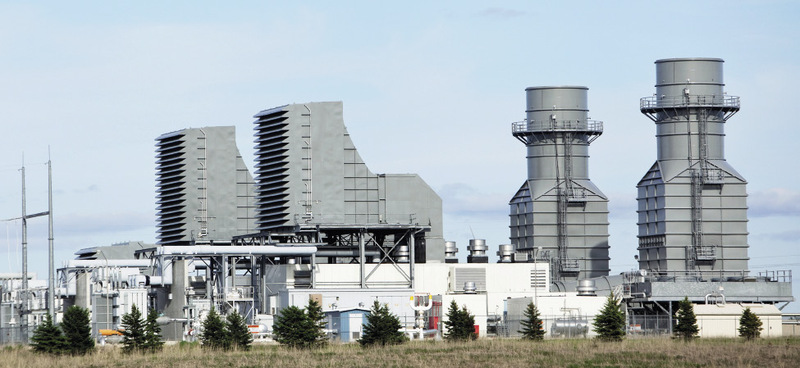
The future of gas turbines
South Africa has only recently started using gas for power stations so there is still a supply that will last for many years. Two of the new gas-turbine power stations, Ankerlig in Atlantis, and Gourikwa in Mossel Bay, both in the Western Cape, are going to double the size of their generators in the next few years, adding a lot of power to the national grid.
Reasons for using this type of energy source
As explained earlier, the ability to start a power station without power from the same network is very important for the national grid. There is still plenty of gas available in the world, however, in South Africa only small amounts can be mined. After pipes have been placed into a gas field it will supply the power station without needing to be mined or transported.
A gas field is an underground area where organic matter has decayed to form large pockets of gas trapped by layers of rock.
Impact on the environment
Burning gas produces much less sulphur dioxide, nitrogen oxide and ash than burning coal. But it is a fossil fuel, so it still produces carbon dioxide pollution.
Do you think gas-burning power stations will have a big impact on generating electricity in South Africa?
Questions on gas-turbine power stations
1. Write down the positive and negative impacts you think burning gas for electricity will have.
|
Positive |
Negative |
Topic B: Nuclear power stations
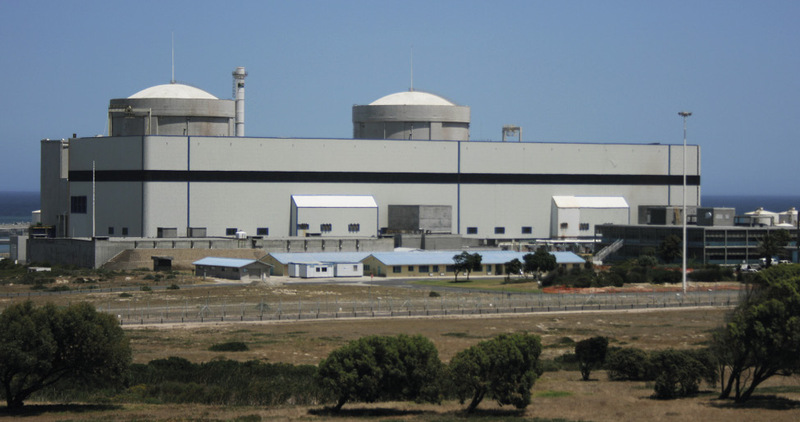
There is a nuclear power station, called Koeberg, close to Cape Town.
Unlike gas-burning or coal-burning power stations, a nuclear power station operates using three separate water systems. One of the biggest fears that people have about nuclear power stations is that radioactive material might escape and pollute the air of nearby areas.
Radioactive substances give off energy that is dangerous to living things. It can cause cancer and other health risks, so it is important that people are shielded from radioactive material.
It is very important for the three systems to beseparate. The first system, the radioactive water in thereactor, is in a closed system. It does not come into contact with the other two systems and therefore does not contaminate the water in these systems. The second water system cools down the radioactive steam that has driven the turbines. It flows through the condensers where the third water system cools the steam back into water. The first water system circulates back to the steam generator where it is turned into steam again.
The third cooling system for the condensers uses sea water at a rate of 80 tons per second to cool the steam. After it has cooled down, the steam is returned to the sea.
- Reasons for using this type of energy source
Many places don't have a supply of fossil fuels to power generators. Small amounts of nuclear fuel can generate enormous amounts of electricity.
Nuclear-power stations require very little maintenance. Because the water used in the first system is recycled, there is very little waste of precious water. The cooling water is unpolluted and returned to the sea.
- Impact on the environment
Radioactive material creates radioactive waste, which is extremely dangerous. Although the amount of waste is very small, it remains active and dangerous for many thousands of years! There is currently no long-term solution for the safe storage of radioactive waste. The best solution at the moment is to put it in very thick layers of concrete and lead, and bury it where no one is likely to dig it up. Many countries do not use nuclear fuel for power since they are concerned that even the buried waste will harm the environment. Nuclear power has been used around the world since the 1950s as an alternative source of energy.
Question on nuclear-power stations
1. List the positive and negative aspects of this type of energy in the table below.
|
Positive |
Negative |
Topic C: Solar power
Solar power means that the heat and light of the sun is used as a source of energy. Solar energy is a realistic option in South Africa since it is such a sunny country. South Africa experiences more sunshine than mostplaces in the world, and there is a lot of potential forthe widespread use of solar power. Solar power wouldbe a very good idea in low-income housing projects,but the initial cost of solar energy is very high as largeareas of solar panels are needed.
Solar panels, or photovoltaic cells, convert sunlight to electricity.
Solar energy is a very good alternative for areas that are far away from the national grid, such as farms, rural clinics and water-pumping stations. In these cases, heat can be produced to power generators or photovoltaic cells can be used to produce electricity directly from sunlight. South Africa does not have a solar-powered plant yet, but ESKOM is currently constructing a solar-powered plant in Northern Cape. To help you understand how this will work, look at Figure 9 below that shows how mirrors and sunlight can be used to heat up a can of water.
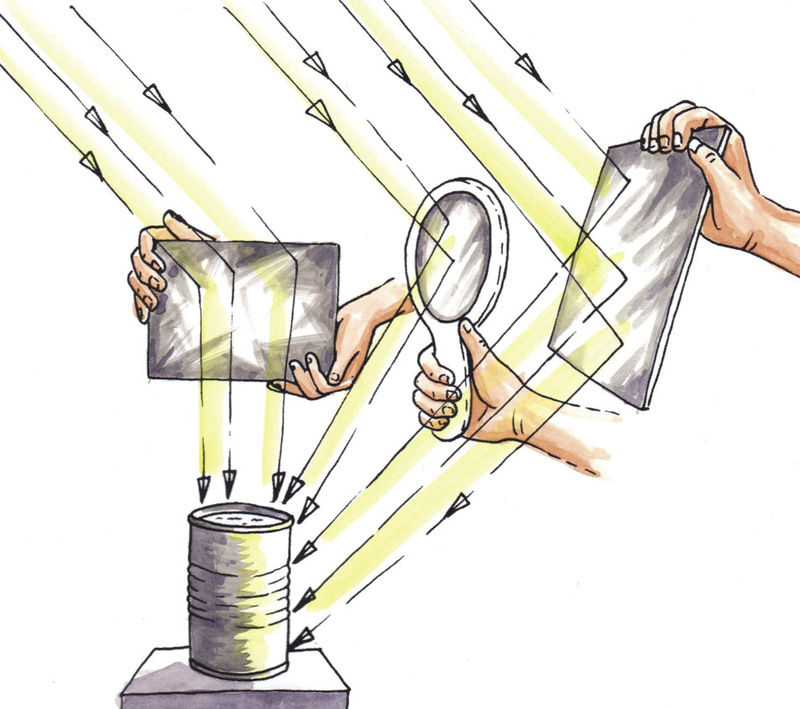
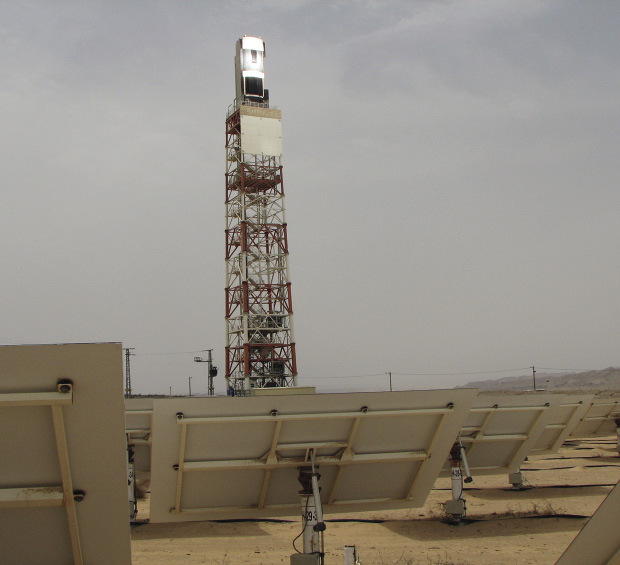
How does a steam-driven solar-power station work?
The solar-power station shown in Figure 10 has thousands of large mirrors, known as "heliostats", that move to follow the sun and reflect the heat to a point on a tower. Salt water is pumped up the central tower, where it is heated to approximately 600 °C. This water is then used to generate steam. The steam is used in the same way as it is in a coal-power station to generate electricity.
- Reasons for using this type of energy source
Solar energy is a realistic option in any sunny country. Solar energy can be used in areas far away from the national grid and can be set up to provide power for smaller communities.
We could take the pressure off South Africa's largely coal-based energy supply by using solar power. This would also give the country a larger overall energy capacity and help us to achieve our target of a 34% reduction in carbon-dioxide emissions by 2020.
- Impact on the environment
Solar power produces no pollution. However, the power stations can take up a lot of space due to the large mirrors. They could be regarded as visual pollution.
Question on solar-power stations
1. Write the positive and negative aspects of using solar power to generate electricity in the table below.
|
Positive |
Negative |
Topic D: Hydroelectric-power generation
The flow of water can be used instead of steam to drive turbines. In hydroelectric- power stations, the potential energy of water stored in a dam is converted into electrical energy. There are two different types of hydroelectric-power stations.
- A simple hydroelectric-power station uses the downwards flow of water to generate electricity.
- A hydroelectric-pumped storage scheme can also pump water back into the dam during times when there is electricity from other power stations that is not being used. Such a scheme plays the role of a rechargeable battery, is it stores electricity when it is not being used. It can also be used in the same way as a simple hydroelectric-power station to generate electricity, by letting water flow downwards out of the dam.
Hydroelectricity is renewable and does not pollute the environment. Large-scale hydroelectric schemes are, however, expensive and require the construction of large dams that have an impact on the environment and communities. Imagine you lived along a river, and you were ordered to move because a hydroelectric dam was to be built there. How would you feel about it?
Hydroelectric-power stations are able to come on line within three minutes. They are therefore convenient to use during times of the day when there is a very high demand for electricity, when this demand is more than the other power stations can provide.
Unfortunately, due to South Africa's limited water resources, only a small amount of electricity can be generated by hydroelectric-power stations.
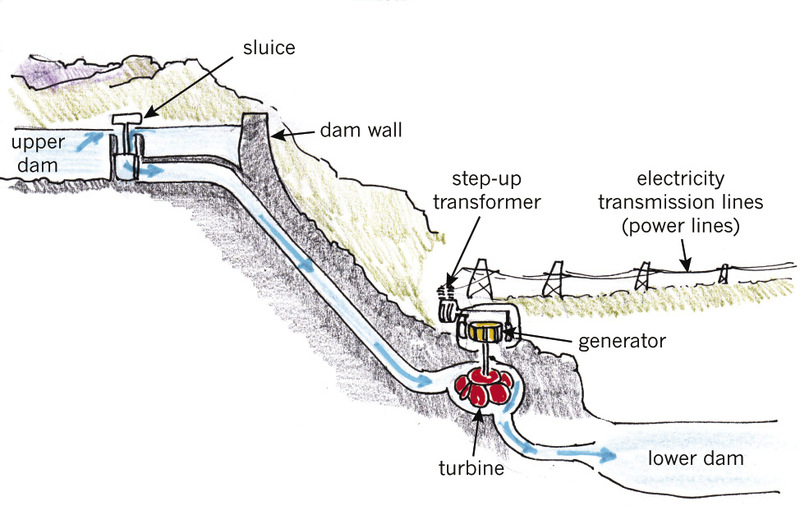
- Reasons for using this type of energy source
It is a renewable energy source and can be used to ensure the country has enough electricity during periods of high electricity consumption. Hydroelectric-power stations are cheap to operate, even cheaper than coal-fired power stations.
- Impact on the environment
Dams and waterways need to be constructed for a hydroelectric-power station. It may be cheap to produce the electricity once the dam is completed, but the costs of building a dam are enormous, and the impact on the countryside can be severe.
An environmental impact plan must be in place, and communities that could be affected have to be taken into consideration. Some people may even have to move because their houses and farms are located where the dam will be built.
Question on hydroelectric-power stations
1. In the table below, write down the positive and negative aspects of a hydroelectric-power station.
|
Positive |
Negative |
Topic E: Wind turbines
For thousands of years, people have used windmills and energy derived from the wind to pump water and to grind mealies. After a breakthrough by scientists, wind can now also be used to generate electricity. Like the sun and water flowing down a river, this is a renewable energy source and does not negatively impact the environment or pollute it. Across the world, wind farms are being built. These are areas where wind is used to turn huge windmills that generate electricity.
Wind speed and direction change from day to day, depending on the weather and the season. When something changes in an unpredictable way, it is called "erratic". The patterns of wind direction and wind speed are studied and used for electricity generation in areas that have consistent winds. This does not mean that there has to be strong winds or gales for the system to work. What is needed is a steady wind that won't damage the machinery.
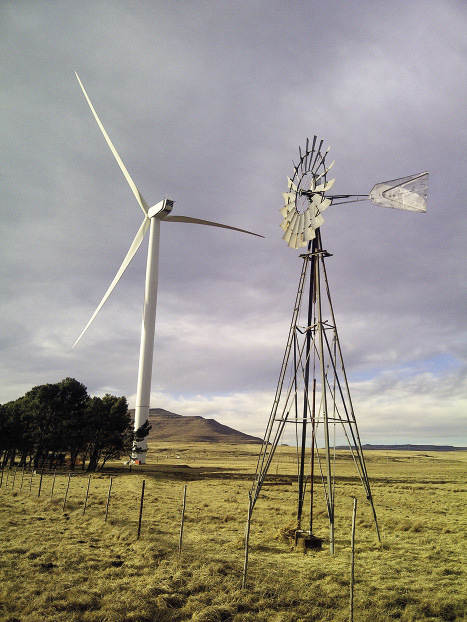
In South Africa, research on the potential of wind energy as an electricity- generating option was carried out in various places. Different ways of generating electricity through wind were studied. An important factor is cost. It doesn't make sense to put systems in place that will make electricity too expensive to buy.
After investigating all the options, ESKOM started the Klipheuwel Windfarm Research Facility on the West Coast near Cape Town in 2002.
The generators need wind speeds of between 47 km and 57 km per hour for full power operation, but they can start generating electricity in winds as low as 11 km per hour. If a gale force wind blows, the turbines shut off automatically at winds over 90 km per hour to prevent damage to the generators.
Wind is an erratic resource that is not always available when needed.
- Reasons for using this type of energy source
Wind is a renewable energy source, and is particularly powerful in coastal areas. It can be used where fossil fuels are unavailable. These conditions are best along the coastlines.
- Impact on the environment
While it is a clean source of energy in terms of greenhouse gases, environmental impacts can include noise, visual pollution as well as affecting birdlife. The farms need large pieces of land, which in some places can be expensive to buy.
Questions on wind turbines
1. Do you think ESKOM should build more wind turbines?
2. Write down the positive and negative aspects of this form of generating electricity in the table below.
|
Positive |
Negative |
Transmission of electricity across the country
The electricity that power stations generate is distributed across the whole country.
The map on the next page shows the main transmission lines that are used to distribute electricity from the power stations to different parts of the country.
Transmission means the action or process of sending something.
Distribution refers to the action of sharing something among a number of recipients.
The combination of the transmission and the distribution cables form a network called the national grid. Electricity is fed into the national grid, and it has to be distributed across the country to cities, towns and rural areas.
The South African government announced its policy to provide free basic services to the poor in 2000. The government has focused mainly on electricity supply, which has led to a higher demand on our national grid.
Electricity supply must be consistent and reliable, since electric equipment can be damaged if there are changes in the voltage and current.
It is very difficult to store large quantities of electrical energy. The energy provider must always match the demand of the consumers. These consumers range from households to huge factories, transport systems and the use of heavy machinery.
Specific equipment has to be installed to ensure that the correct voltages reach the users. In this section, you are going to learn about this type of equipment.
As the demand increases, more power stations must be brought on line. This means that the power they generate needs to be added to the national grid.
It is interesting to note that the electricity demand not only varies from day to day, but from minute to minute. The peak demand periods are early in the morning and in the evening.
Peak demand means the highest demand during a day.
These pylons transmit high-voltage current between the power stations and the substations.
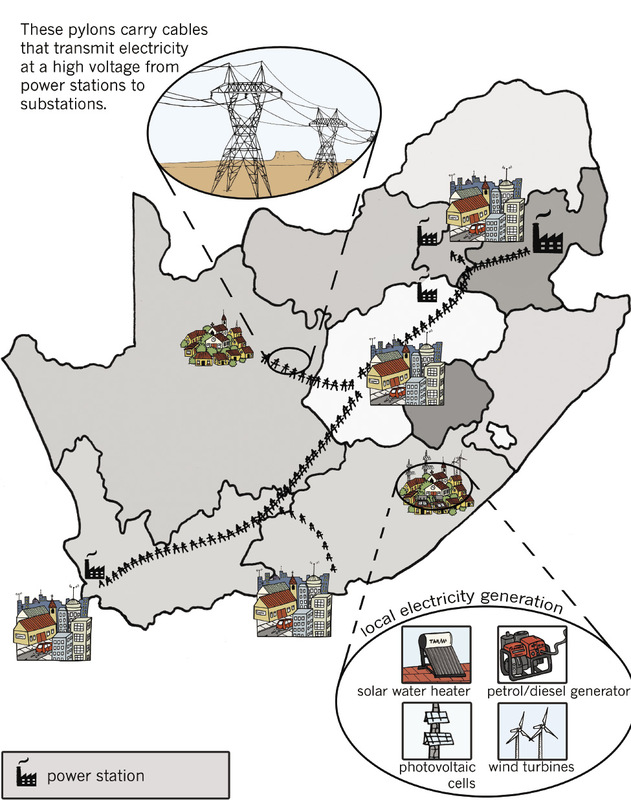
Step-down and step-up transformers
Electricity is transferred from power stations to consumers over long distances through the wires and cables of the national grid. When a current flows through a wire, a bit of energy is lost in the form of heat. The higher the current, the more energy is lost. To reduce these losses, the national grid transmits electricity at a low current, but this requires a high voltage. Remember Ohm's law!
Step-up transformers are used at power stations to produce the very high voltages needed to transmit electricity through the national grid's power lines. When the electric energy reaches the consumer area, it is transformed, which means changed, to a lower and safer voltage. Step-down transformers are used locally in sub-stations to reduce the voltage to safe levels.
If you don't quite understand this, think of water flowing through apipe. The wider the pipe, the more water can be pushed through. When it reaches the other end, the water is funnelled into smaller pipes to be used in homes and factories. The same principle is used to distribute electricity.
- A transformer that increases the voltage is called "a step-up transformer".
- A transformer that decreases the voltage is called "a step-down transformer".
Figure 14 shows how electricity reaches your house so that you can turn on the lights and watch educational programmes on your television.
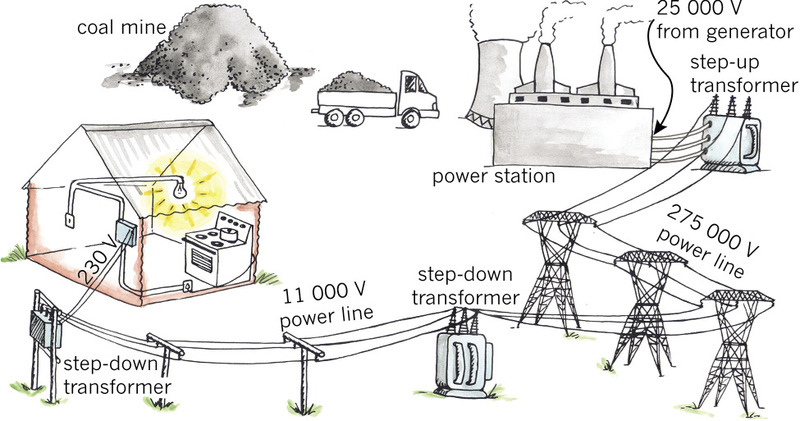
What have you learnt?
1. Name three renewable ways in which electricity can be generated.
2. What is the national electrical energy grid?
The national electricity energy grid is often simply called the national grid.
3. What is the function of a transformer?
4. In the area where you live, what, in your opinion, will be the most suitable energy source to be converted to electricity for your community? Why do you say so?
Next week
During the next three weeks, you will do your mini-PAT for this term. You will design and build an alarm system.
Circuits with logic control
In this chapter, which brings you to the end of this term, you will start by revising the circuits you made in Chapter 7 at the beginning of this term. Then you are going to use this knowledge to make an alarm system for a shopkeeper.
You will only do individual work during this Mini-PAT.
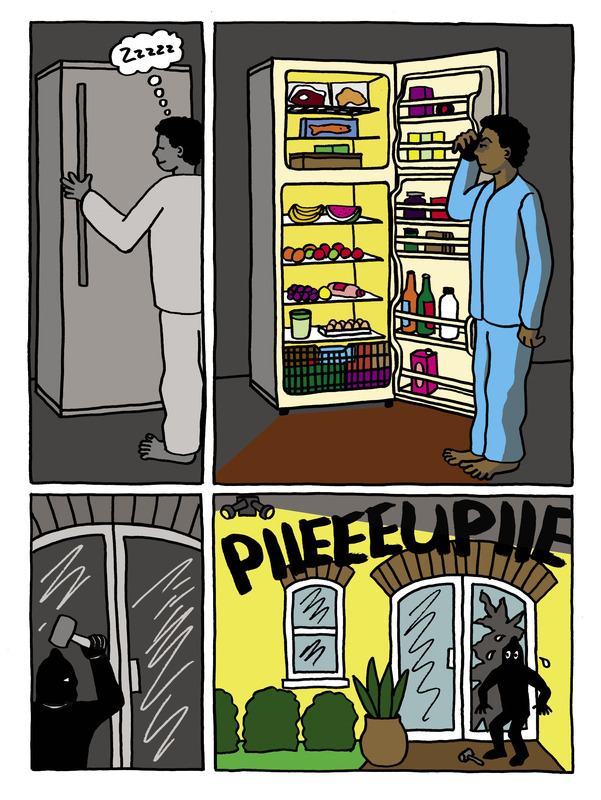
Week 1
Circuit diagrams and ohm's law
This section revises the circuits which you learnt about in Chapter 7. You found that the more cells you connected in series, the brighter the bulb glowed.
Revise the effect of connecting more cells in series (45 minutes)
You will need:
- a cell holder big enough for three cells,
- two or three crocodile-clip conducting wires, and
- a light bulb rated for 3,8 V or slightly more.
Look at the three circuits below:

1. What voltage does the battery in circuit 3 promise to give?
2. Predict how bright the bulbs will glow in circuits 1 to 3. To show your prediction, draw brackets around the bulbs in the diagram. (⊗) means dim, ((⊗)) means medium bright and (((⊗))) means very bright.
3. Now build each of these circuits and test your predictions. Does the bulb in each circuit glow as brightly as you predicted it would?
The relationship between voltage and current
If the current through the bulb is small, the bulb will glow dimly, and if the current is big, the bulb will glow brightly.
4. Write a sentence about the relationship between the voltage and the current. Use the following phrases in your sentence:
- "across the bulb",
- "through the bulb",
- "the voltage is",
- "the bigger is the current", and
- "the bigger".
5. You can state the relationship between current and voltage in another way. Complete the following sentence:If you increase the __________ across the bulb, you also increase the __________ the bulb.
The sentence above summarises Ohmâs law.
Revise circuits with resistors in series and parallel (45 minutes)
For this activity, you will need:
- a battery of three cells,
- three bulbs rated for 3,8 volts, and
- six crocodile-clip conducting wires.
1. The diagrams in Figure 3 show you the circuits you are going to build. Before you build them, show your predictions of how bright the bulbs will glow on the diagrams using brackets as you did before. Then connect the components and test your predictions.

2. Look at Figure 4, and show your predictions of how bright the bulbs will glow when they are connected in parallel. Then connect the components and test your predictions.

How a door-operated push switch works (30 minutes)
A refrigerator has a light bulb inside that lights up when you open the door.
1. Will the light turn off when you close the fridge door? Why?
2. Figure 5 shows a photo of a fridge with its door open. On this photo, find the switch that controls the light and draw a circle around it with your pencil.
3. Homework: When you open a fridge at home, press this button in to see whether the light goes off.
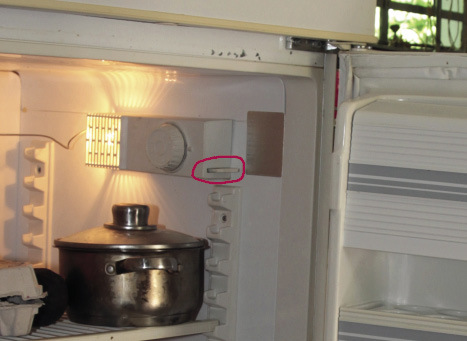
- Many push switches turn on a circuit when they are pressed in, and turn off the circuit when they are is not pressed in.
- But the push switch for the fridge light works the other way round. It turns off the circuit when it is pressed in, and it turns on the circuit when it is not pressed in.
Figure 6 shows you how this type of switch works. The switch opens the circuit as long as the door is closed.
4. What happens when the door moves away from the plastic knob? How does the switch complete the circuit?
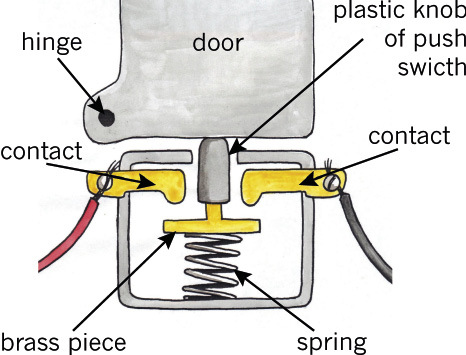
Week 2
Logic gates and truth tables
Design brief and specifications
Switches with and-type control (15 minutes)
The circuit in Figure 7 has AND-type control. Now let's see where people would use a circuit such as this one. Figure 8 shows an electric paper-cutting machine that is used to cut many sheets of paper simultaneously. An electric motor turns gears that press the blade of the machine down to cut the paper.
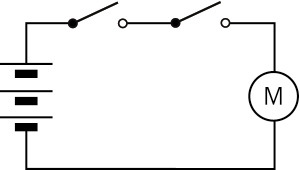
A worker who uses the machine could easily cut his or her fingers, so the machine has a safety system in place.
To make the blade come down, the worker must use both hands to press two switches at the same time. If he or she presses only one switch, the blade will not move. So the machine will not work unless his or her hands are both out of the way.
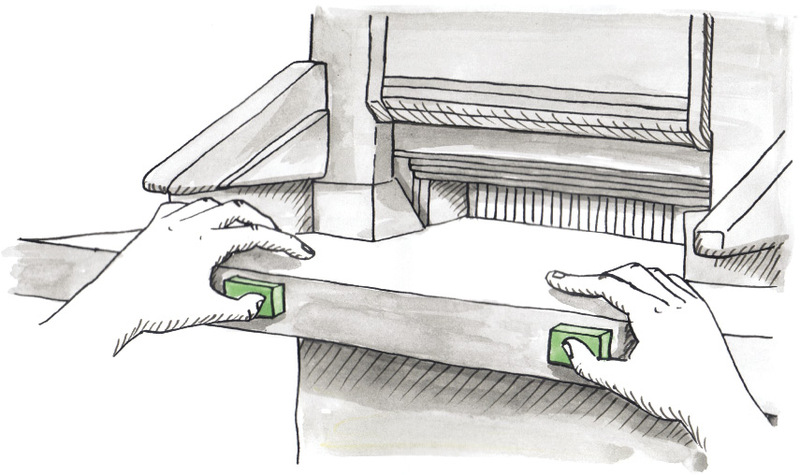
This machineâs circuit has AND-type control. Switch 1 and Switch 2 must both be closed, by pressing them, before the motor will work.
Switches with or-type control (15 minutes)
The circuit in Figure 9 has OR-type control. This type of control is used to switch on the light inside a car when you open one of the front doors. This is very useful when you get in or out of the car at night.
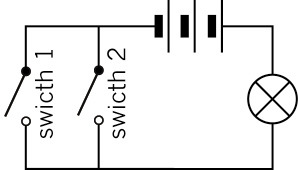
The light turns on when the driver opens the door, and turns off when that door is closed. If a passenger gets in at the other front door, the light goes on again, even if the driver's door is closed.
So the car has a circuit that switches on the light if either the driver's door is open or the passenger's door is open. This circuit has OR-type control.
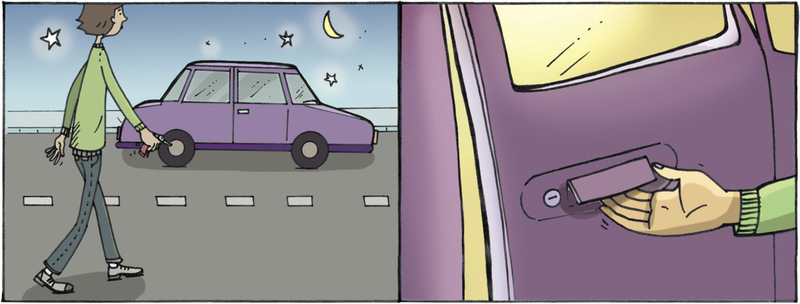
A carâs cabin light uses OR-type control because the bulb lights up if either the switch on the driverâs door or the switch on the passengerâs door is closed (on). It also lights up if they are both closed (on).
1. Look at the circuit in Figure 9. Both the switches are open (off). How can you get the bulb to light up? Think of three things you can do with the switches.
The door-operated switch for the light inside the car is the same type of switch used for a fridge light, as shown in Figures 5 and 6.
Truth tables (30 minutes)
A computer gives many outputs depending on many inputs. To do this, it uses many AND-type and OR-type circuits inside a more complicated circuit. The AND and OR parts of the complicated circuits are called "logic gates".
Computer designers and programmers need methods to write down all the possible "states" that the system can be in. A state is one possible combination of values for all the inputs. "Truth tables" help them to write down all the possible states. Computers have millions of possible states. But to understand the method of truth tables, you only need to understand the truth tables of systems with a small number of states.
Look back at Figure 8, showing the electric paper-cutting machine. The operator has to press both switches to make the cutting blade move. So the circuit controlling the motor uses AND-type control.
Below is a truth table for this circuit. The inputs are the two switches. Each row of the table shows one possible combination of the inputs, and the output corresponding with it. So each row shows one possible state.
|
switch 1 |
switch 2 |
Does the blade move? |
|
off |
off |
no |
|
off |
on |
no |
|
on |
off |
no |
|
on |
on |
yes |
A truth table is sometimes written using numbers instead of "on" or "off":
- For the inputs, which are the switches, a "1" means "on" and a "0" means "off".
- For the outputs, a "1" means "yes, it gives the output", and a "0" means "no output".
1. Complete the truth table below for the paper-cutting machine's circuit.
|
switch 1 |
switch 2 |
output (Does the blade move?) |
|
0 |
0 |
0 |
|
0 |
1 |
|
|
1 |
||
|
1 |
2. Now make a truth table for the light inside the car. If any one of the two front doors is open, the light is on. So this is a truth table for OR-control.
|
state |
driver door switch |
passenger door switch |
output (Does the light turn on?) |
|
only driver door open |
1 |
0 |
|
|
only passenger door open |
|||
|
both driver and passenger doors open |
|||
|
no door open |
A truth table shows all the possible states a circuit can be in, depending on the different combinations of the inputs. It is a list of the inputs and the output or outputs for every possible state.
Combining and-control with or-control (15 minutes)
Many buses have push switches for passengers to let the driver know they want to get off at the next stop. The circuit diagram might look like Figure 11. In this circuit diagram, there are two push switches for passengers. Any one of these switches can ring the bell next to the driver.
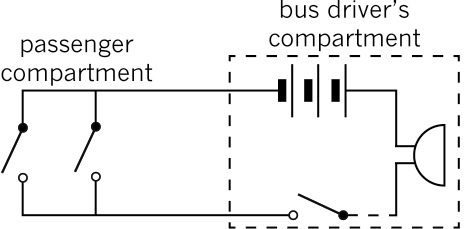
1. Write SW1 and SW2 next to the two switches for the passengers.
When school learners go on an excursion, they sometimes ring the bell many times just for fun. This prevents the driver from concentrating on the road, so he or she has a "master switch" to turn off the bell.
2. Which switch gives the bus driver control over the whole circuit? Write SWmaster next to that switch.
The passengers have OR-control because switch SW1 or switch SW2 can ring the bell. However, the driver has AND-control. For the bell to ring, SWmasterand one of SW1 or SW2 must be on.
3. Complete a truth table below for the bell circuit of the bus.
|
SWmaster |
SW1 |
SW2 |
output from the bell |
|
1 |
0 |
0 |
|
|
1 |
1 |
0 |
|
|
1 |
0 |
1 |
|
|
1 |
1 |
1 |
|
|
0 |
0 |
0 |
|
|
0 |
1 |
0 |
|
|
0 |
0 |
1 |
|
|
0 |
1 |
1 |
Write a design brief and specifications (15 minutes)
The scenario:
Mr Abdullahi has set up a shop. The customers are happy with his low prices. He sells food and clothing cheaply because he co-operates with other shopkeepers in the area. They work together to negotiate with the big suppliers of clothing and food to get cheaper prices.
Sometimes Mr Abdullahi is alone in the shop. If he has to work in the office at the back of the shop, he closes the two front doors of the shop, but the doors are not locked. He will only know if someone comes in at one of the doors if he sees them or if they call him.
Can you make him an alarm system that will tell him when a door opens? Sometimes Mr Abdullahi has an assistant in the shop, and then he does not need an alarm, so he wants a switch to turn the alarm system on and off.
1. Write the brief here. The design brief is a short statement that describes the need and what type of solution will meet that need.
Project brief:
I am going to design and make a
2. Now write specifications for the solution. Specifications have detail about the system you are going to make. Remember that the system:
- should make a sound when either one of the two doors are open, and
- should have a switch to turn the whole system off.
Specifications:
Investigate: components you could use (15 minutes)
1. What type of devices can you use for the alarm to make a loud sound?
2. What type of battery can you use? Remember that a 9 V battery will burn out motors that are rated for 1,5 V. Beepers also have their own voltage ratings, and you must find out what these are.
3. How can you make a switch that will close the circuit when the door is opened? Find a switch in this chapter or another chapter that will meet these requirements.
Design: draw a circuit diagram (15 minutes)
1. Should the alarm system use AND-control or OR-control? Explain.
2. Often designers look at circuits that have already been designed, to see whether any of those circuits will do the job. Look at Figures 7, 9 and 11 again. Which of these circuits will work?
3. Draw that circuit again in the space below. Give names for the different switches and show them as labels on your circuit diagram.
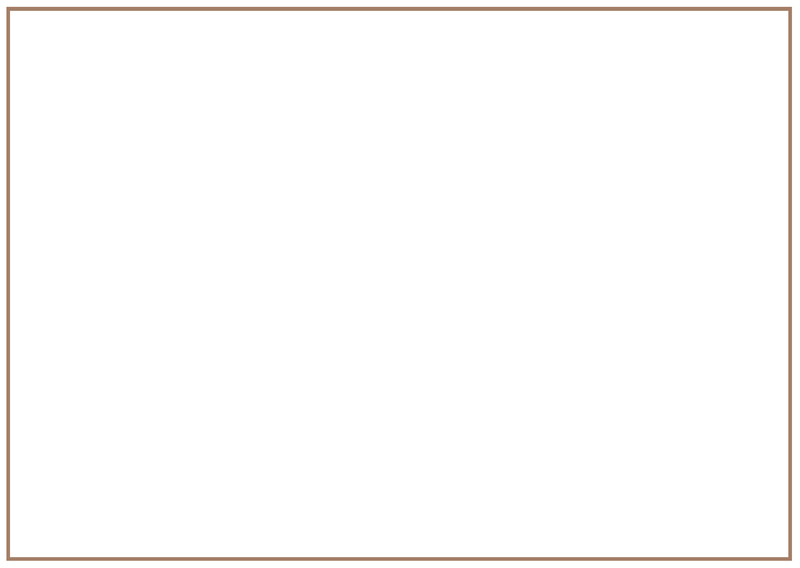
4. Show more information on your circuit diagram in Figure 12. Draw dashed lines around the part of the circuit that is in the front of the shop, and other dashed lines around the part that is in the office.
Hint: Look at Figure 11 again to see how dashed lines were used to show the part of the circuit in the bus driver's compartment.
Week 3
Design, make and communicate
Draw the layout of your alarm system in the shop(15 minutes)
Figure 13 shows a simple sketch of the shop.
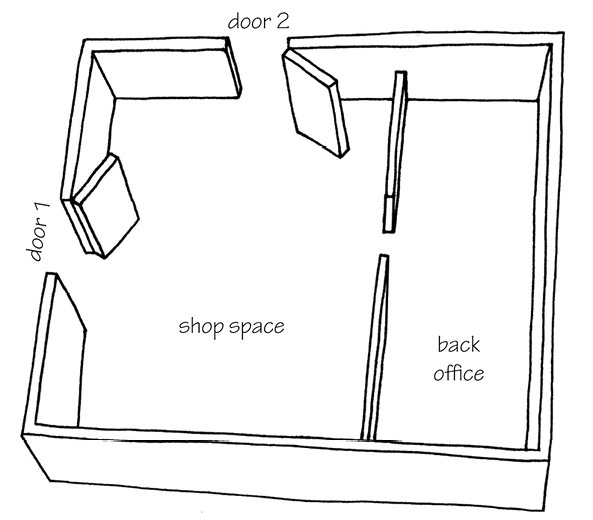
Draw on Figure 13 to show where you will put all the switches and other circuit components. Also show the connecting wires for the circuit. Put in labels for the circuit components. The circuit components should be connected as shown by the circuit diagram that you made for Figure 12.
Make a cardboard model of the shop (15 minutes)
Make a model of the shop out of a cardboard box. Cut two doors in the box. The model should not have a roof, so that you can see inside it. Make the model as simple as possible, otherwise you will not have enough time to finish building the alarm system.
Design a door-operated push switch (15 minutes)
Figures 14 to 16 show examples of how push switches that are off when they are pressed in can be made.
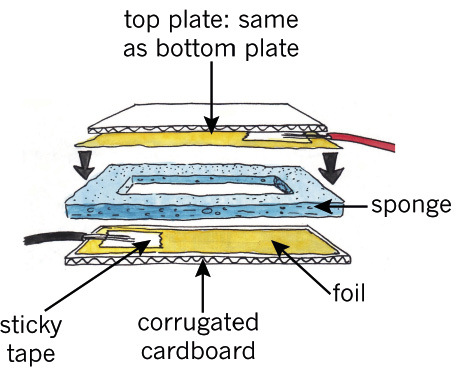
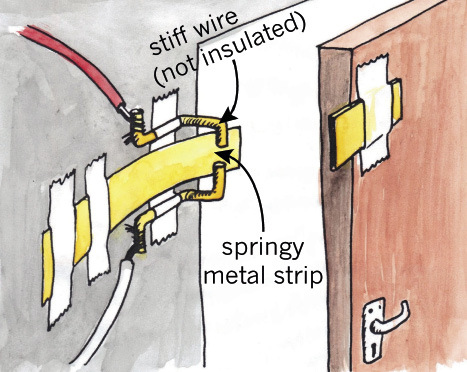
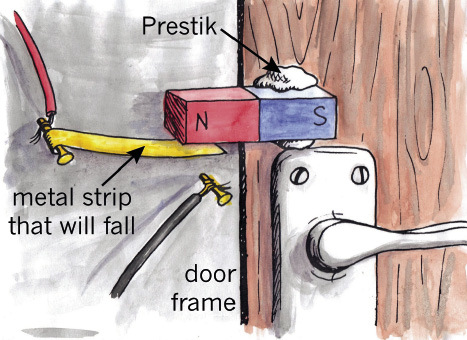
Use an idea or ideas from these examples to design your own door-operated push switch that is on when the door is open and off when the door is closed. Make a sketch of your design on the next page. Add labels to explain the different parts of your switch design.

Make the switches for your alarm system (30 minutes)
Make two of the door-operated push switches that you designed. Remember that they need to fit on the doors of your cardboard model of the shop.
Do not make a master switch, as you don't have enough time for that. You can simply connect two crocodile clips of conducting wires to "switch on" the master switch, and disconnect them to open the circuit and "switch off" the master switch.
Add your circuit to your model of the shop (30 minutes)
Now add all your circuit components and conducting wires to your cardboard model of the shop. Your design of the placement and wiring of the alarm system in Figure 13 will help you to connect all the circuit components in the correct way.
Stick the wires to the walls of the box with tape to make your model neat.
Connect all the circuit components.
In a real building, the alarm wires are stuck to the walls or are in the ceiling. The door switches are on the inside of the doors. If they were on the outside, a burglar could disconnect them.
Evaluate: test your alarm system (15 minutes)
When you evaluate the project, ask yourself: "Did I solve Mr Abdullahi's problem?" The following questions will help you to test whether your alarm fulfils all of the specifications. Do these tests:
1. Does the alarm make a noise when you open only door 1?
2. Does the alarm make a noise when you open only door 2?
3. Does the alarm make a noise when you open both doors?
4. Can Mr Abdullahi switch the system off and leave the doors open?
5. Complete a truth table for the system.
|
master switch |
switch 1 |
switch 2 |
output |
|
1 |
|||
|
1 |
|||
|
1 |
|||
|
1 |
|||
|
0 |
0 |
0 |
|
|
0 |
0 |
1 |
|
|
0 |
1 |
0 |
|
|
0 |
1 |
1 |
Homework: make an advertisement for your alarm system
Mr Abdullahi likes your system so much that he offers to advertise it to other shopkeepers. He thinks some of them will pay you to build and install alarms for them.
He asks you to make a poster that shows the shop and the doors, some of the parts of the alarm system, with a few sentences that explain how the system works.
Make a poster to advertise your alarm system on the next page. But first sketch rough ideas for your poster on this page.





